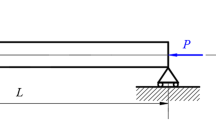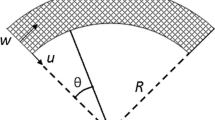Abstract
The elastic buckling analysis and the static postbuckling response of the Euler–Bernoulli microbeams containing an open edge crack are studied based on a modified couple stress theory. The cracked section is modeled by a massless elastic rotational spring. This model contains a material length scale parameter and can capture the size effect. The von Kármán nonlinearity is applied to display the postbuckling behavior. Analytical solutions of a critical buckling load and the postbuckling response are presented for simply supported cracked microbeams. This parametric study indicates the effects of the crack location, crack severity, and length scale parameter on the buckling and postbuckling behaviors of cracked microbeams.
Similar content being viewed by others
References
J. Yang and Y. Chen, “Free Vibration and Buckling Analyses of Functionally Graded Beams with Edge Cracks,” Compos. Struct. 83, 48–60 (2008).
L. L. Ke, J. Yang, and S. Kitipornchai, “Postbuckling Analysis of Edge Cracked Functionally Graded Timoshenko Beams under End Shortening,” Compos. Struct. 90, 152–160 (2009).
J. Loya, J. Lopez-Puente, and R. Zaera, J. Fernandez-Saez, “Free Transverse Vibrations of Cracked Nanobeams Using a Nonlocal Elasticity Model,” J. Appl. Phys. 105, 044309 (2009).
S. M. Hasheminejad, B. Gheshlaghi, Y. Mirzaei, and S. Abbasian, “Free Transverse Vibrations of Cracked Nanobeams with Surface Effects,” Thin Solid Films 519, 2477–2482 (2011).
K. Torabi and J. N. Dastgerdi, “An Analytical Method for Free Vibration Analysis of Timoshenko Beam Theory Applied to Cracked Nanobeams Using a Nonlocal Elasticity Model,” Thin Solid Films 520, 6595–6602 (2012).
Sh. Hosseini-Hashemi, M. Fakher, R. Nazemnezhad, and M. H. Sotudeh-Haghighi, “Dynamic Behavior of Thin and Thick Cracked Nanobeams Incorporating Surface Effects,” Composites. Pt B 61, 66–72 (2014).
J. Ch. Hsu, H. L. Lee, and W. J. Chang, “Longitudinal Vibration of Cracked Nanobeams Using Nonlocal Elasticity Theory,” Current Appl. Phys. 11, 1384–1388 (2011).
J. A. Loya, J. Aranda-Ruiz, and J. Fernandez-Saez, “Torsion of Cracked Nanorods Using a Nonlocal Elasticity Model,” J. Phys. D: Appl. Phys. 47, 115304 (2014).
F. Yang, A. C. M. Chong, D. C. C. Lam, and P. Tong, “Couple Stress Based Strain Gradient Theory for Elasticity,” Int. J. Solids Struct. 39, 2731–2743 (2002).
M. Mohammad-Abadi and A. R. Daneshmehr, “Size Dependent Buckling Analysis of Microbeams Based on Modified Couple Stress Theory with High Order Theories and General Boundary Conditions,” Int. J. Eng. Sci. 74, 1–14 (2014); DOI: 10.1016/j.ijengsci.2013.08.010.
M. Akbarzadeh Khorshidi and M. Shariati, “Free Vibration Analysis of Sigmoid Functionally Graded Nanobeams Based on a Modified Couple Stress Theory with General Shear Deformation Theory,” J. Brazil. Soc. Mech. Sci. Engng. 38 (8), 2607–2619 (2016); DOI: 10.1007/s40430-015-0388-3.
A. Akbarzadeh Khorshidi, M. Shariati, and S. A. Emam, “Postbuckling of Functionally Graded Nanobeams Based on Modified Couple Stress Theory under General Beam Theory,” Int. J. Mech. Sci. 110, 160–169 (2016); DOI: 10.1016/j.ijmecsci.2016.03.006.
R. D. Mindlin, “Influence of Couple-Stresses on Stress Concentrations,” Exp. Mech. 3, 1–7 (1963).
A. C. M. Chong, F. Yang, D. C. C. Lam, and P. Tong, “Torsion and Bending of Micron-Scaled Structures,” J. Mater. Res. 16, 1052–1058 (2001).
D. C. C. Lam, F. Yang, A. C. M. Chong, et al., “Experiments and Theory in Strain Gradient Elasticity,” J. Mech. Phys. Solids 51, 1477–1508 (2003).
S. K. Park and X. L. Gao, “Bernoulli–Euler Beam Model Based on a Modified Couple Stress Theory,” J. Micromech. Microeng. 16, 2355–2359 (2006).
S. A. Emam, “Analysis of Shear-Deformable Composite Beams in Postbuckling,” Composite Structures 94, 24–30 (2011); DOI: 10.1016/j.compstruct.2011.07.024.
B. Akgoz and O. Civalek, “Strain Gradient Elasticity and Modified Couple Stress Models for Buckling Analysis of Axially Loaded Micro-Scaled Beams,” Int. J. Eng. Sci. 49, 1268–1280 (2011).
Author information
Authors and Affiliations
Corresponding author
Additional information
Translated from Prikladnaya Mekhanika i Tekhnicheskaya Fizika, Vol. 58, No. 4, pp. 171–179, July–August, 2017.
Original Russian Text © M.Akbarzadeh Khorshidi, M. Shariati.
Rights and permissions
About this article
Cite this article
Akbarzadeh Khorshidi, M., Shariati, M. Buckling and postbuckling of size-dependent cracked microbeams based on a modified couple stress theory. J Appl Mech Tech Phy 58, 717–724 (2017). https://doi.org/10.1134/S0021894417040174
Received:
Revised:
Published:
Issue Date:
DOI: https://doi.org/10.1134/S0021894417040174




